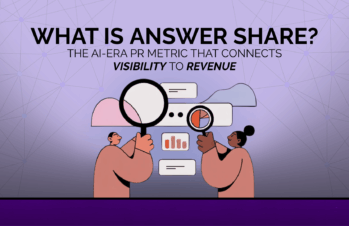If you’re looking to up your B2B earned media game, it’s essential to understand the difference between proactive and reactive PR strategies. Any good PR strategy has a mix of tactics in the plan, from events to media pitches and more. We tend to think of PR as the all-encompassing department that handles the company’s image, but there are really two sides to the PR coin: proactive and reactive. Proactive PR includes media opportunities that you create. Alternatively, reactive PR encompasses the leads that come to you—through the news cycle or through a third-party source.
Both proactive and reactive PR are essential components of a successful public relations strategy. By being proactive, you can establish your brand as a thought leader in your industry and build trust with your target audience. By taking a reactive approach, you can quickly respond to any issues that do arise and mitigate any damage to your brand.
Proactivity vs. Reactivity: What’s the Difference?
Proactive media solutions involve anticipating and creating opportunities to generate positive publicity. This means getting ahead of the news cycle and shaping the narrative through carefully crafted press releases, announcements, and other outreach efforts. This approach is focused on building relationships with media outlets and establishing a positive image for your brand. Proactive public relations is about staying ahead of the curve and telling your own story.
On the other hand, reactive public relations is all about responding to external events or issues. Reactivity involves monitoring news cycles and jumping on relevant topics to generate media coverage.
Why You Need Both Proactivity and Reactivity in Your PR Strategy
Both proactive and reactive strategies have their benefits. Proactive PR allows you to establish your brand’s identity, communicate your message, and build relationships with the media. Reactive PR enables you to stay relevant and timely, generate buzz, and ride on the coattails of trending news stories.
While proactive and reactive PR strategies have distinct advantages, it’s important to note that both are necessary for a successful B2B PR campaign. Here’s why:
Power Ahead with Proactive PR
Proactive PR allows you to take control of your narrative and communicate your message in a deliberate, planned manner. It involves identifying and pursuing opportunities for positive media coverage, such as issuing press releases, securing speaking engagements, and developing thought leadership content. This approach helps you establish your brand’s voice and build relationships with journalists and other influencers.
Reign it in with Reactive PR
Reactive PR allows you to capitalize on breaking news or trending topics to increase your visibility and establish your brand as a relevant, knowledgeable player in your industry. It involves monitoring the news cycle, identifying opportunities, and responding quickly with a thoughtful, strategic approach.
By combining proactive and reactive PR strategies, you can create a comprehensive earned media campaign that maximizes your chances of success. For example, if your proactive efforts have positioned your brand as a thought leader in your industry, a well-timed reactive response to a breaking news story can help you establish yourself as an expert on that topic. Conversely, if your reactive efforts have resulted in a surge of media attention, proactive efforts can help you sustain that momentum by ensuring your brand’s message is consistent and on point.
Ultimately, successful B2B PR campaigns require a balance of both proactivity and reactivity. By taking a thoughtful, strategic approach that incorporates both types of PR, you can increase your chances of success and achieve your PR goals.
Related Reading: Social Media Must-Haves: Proactive and Reactive Social Strategies
Proactive PR Strategies
The benefits of proactive PR are clear—let’s review:
Thought Leadership
In the B2B space, an effective solution to the pain points affecting your target audience is to create thought leadership content such as white papers or industry reports that provide valuable insights. By sharing this content with the right media outlets, you can establish yourself as an expert in your field and increase your brand’s exposure.
Industry Events
Another proactive strategy is to leverage industry events and conferences to connect with journalists and influencers in your space. By attending and participating in these events, you can build relationships with key players in your industry and establish your brand’s presence as a thought leader.
Media & Influencer Relations
Ultimately, building relationships with media outlets and establishing a positive brand image are critical components of any successful proactive PR strategy. You can build strong relationships with media outlets by leveraging social media platforms like X (formerly Twitter) and LinkedIn to connect with journalists and influencers in your space. By following and engaging with these individuals where they tend to gather online, you can begin to establish a rapport and position your brand as a valuable contributor to the conversation.
Another tactic is to personalize your outreach efforts by taking the time to understand the interests and preferences of journalists and influencers. By tailoring your messaging and content to their specific needs, you can increase the likelihood of them taking notice of your brand and sharing your message with their audience.
The key to building relationships with media outlets is to be consistent and genuine in your efforts. By demonstrating a sincere interest in their work and contributing value to the conversation, you can establish yourself as a trusted source and increase your brand’s visibility in the marketplace.
Reactive PR Strategies
Reactive PR can be just as important as proactive PR, especially when it comes to staying relevant and timely in the fast-paced world of B2B earned media. By responding quickly to breaking news and trending topics, you can position your brand as an expert in your field and increase your visibility in the marketplace. This can lead to increased brand awareness, website traffic, and, ultimately, new business opportunities.
Examples of reactive PR strategies in the B2B space include “newsjacking” trending topics by creating rapid responses and content that ties into the conversation, issuing reactive statements or press releases in response to breaking news, and leveraging social media to engage in real-time conversations with industry influencers and stakeholders. For example, in the first few months of the COVID-19 pandemic, many B2B brands pivoted their marketing to focus on pandemic-related issues.
If you want to be effective at reactive PR, you must stay on top of news and trends in your industry and be ready to respond quickly when opportunities arise. This requires a willingness to be agile and adaptable, as well as a commitment to staying informed and engaged with the broader conversations happening across your industry.
When leveraging reactive PR, it’s not only critical to act quickly, but to approach each opportunity with a clear understanding of your brand’s messaging and goals. This helps ensure that your reactive efforts are not just responsive to external events, but they also align with your overall PR strategy.
Finding the Right Balance
By embracing both proactive and reactive PR strategies, you can create a comprehensive and effective earned media campaign that positions your brand as a thought leader and drives real business results. While both strategies are necessary for a successful campaign, it’s important to determine the appropriate mix for a specific brand.
Related Reading: Build a Successful B2B PR Strategy
To strike the right balance, businesses need to consider factors like their industry, target audience, and overall goals. A proactive strategy might be more effective for a brand looking to establish a strong reputation in a competitive market, while a reactive approach could be more suitable for a brand seeking to quickly respond to negative publicity.
A company should also consider its industry and the current landscape. For example, a B2B tech company may need to be more proactive in establishing its brand as a thought leader, while a B2B service provider may need to be more reactive in monitoring news cycles for relevant topics.
Businesses can also benefit from regularly assessing the effectiveness of their PR strategies and making adjustments as needed. This can involve analyzing metrics like media coverage, social media engagement, and website traffic to determine which strategies are resonating with audiences and driving results.
Aligning with Your Marketing Efforts
All public relations contribute to your overall marketing strategy. When looking at proactive PR, consider taking inspiration from existing content, like blog posts and white papers, to inform your thought leadership opportunities and generate additional educational content. Your content marketing strategy can even pull from your press releases, speaking opportunities, and contributed articles to create high-quality pieces of content for your website or social media channels.
Digital marketing plays a large role in your digital PR strategy as well. Align your social media, influencer relations, search engine optimization (SEO), and content marketing to extend the reach of your PR and marketing activities.
Connecting Social Media and PR
As mentioned above, your social platforms can aid with both proactive and reactive PR, connecting you with industry insiders and engaging in real-time conversations online. For proactive PR, social media posts can be leveraged to amplify high-quality content that comes from interviews and published articles, additional thought leadership opportunities, appearances or involvement in industry events, press releases, and blog posts. You can even use your social channels to engage in influencer marketing and build PR campaigns rooted in strong relationships with influencers.
Reactive PR online involves a dedicated approach to your social media content. Communicating with customers after you post new content or sharing user-generated content improves engagement and customer loyalty. Continue to improve the customer experience by inviting your followers to participate in polls, for example, and asking them to share feedback in the comments section. Not only does this provide you with a greater idea of the sentiment around your content, it provides you with engagement metrics.
Related reading: Why Every PR Campaign Needs Social Media Marketing
Use this data to ensure your PR tactics are fitting in with your marketing goals. Are you trying to reach more target customers? Which content performs well? Were you able to create conversations around trending topics? Is your latest interview gaining a lot of positive attention? Figure out which elements of your PR campaigns align with your digital marketing strategies to create synergy between each of your channels and marketing objectives.
Whether you’re proactively planning ways to incorporate PR into your social media campaigns or finding ways to boost engagement and generate more buzz for your brand in reactive situations, social media marketing is just one critical element required to reach your business goals.
When done right, social media serves as an extension of your PR efforts, producing short, quick pieces of content that can contribute to a larger story or PR campaign. The key lies in understanding when to proactively push content online and when to leverage your expertise in reaction to what’s happening around you.
Ultimately, finding the right balance between proactive and reactive PR strategies across marketing channels requires a thoughtful and strategic approach. By taking the time to assess your needs and goals, businesses can develop a PR campaign that is both effective and efficient.Ready to balance your proactive and reactive PR strategies? Reach out.




